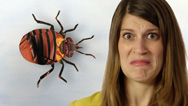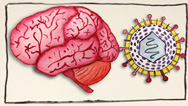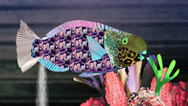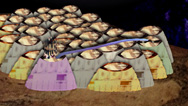Sea Turtles Get Herpes, Too
- Posted 07.28.16
- NOVA
Sea turtles can get herpes. And human pollution might be making their flare-ups worse. Find out how in this episode of Gross Science.
Transcript
Sea Turtles Get Herpes, Too
Posted: July 7, 2016
Hey everyone. The grossest thing I heard this week is that sea turtles get herpes! And human pollution is probably making their flare-ups more frequent.
I’m Anna and this is Gross Science.
So, New Scientist recently reported that more and more green sea turtles are turning up with crippling tumors around Australia’s Great Barrier Reef. The condition is called fibropapillomatosis, or FP, and it’s likely caused by a herpesvirus. There are actually lots of different types of herpesviruses in the world—for example, separate herpesviruses cause cold sores and chickenpox in humans. But this particular one is turtle-specific, so there’s no need to worry about catching it yourself. However, like the human herpesviruses, this virus can lie dormant in the turtle’s body, and only cause flare ups in the form of tumors under certain conditions.
Now, the tumors are benign, but according to New Scientist, they can spring up on the turtle’s flippers, tail, shell, internal organs, and eyes. And if they do grow on the eyes, they can block the turtle’s vision and keep it from finding food or evading predators.
So how does pollution play into all this? Well, Karina Jones, a scientist with James Cook University in Townsville, Australia, told New Scientist that the flare ups typically occur in “very localized hotspots around the world where there is heavy human activity.”
Now, no one’s quite sure how pollution and FP are linked, but I read a 2010 paper published in PLoS One that surveyed FP among sea turtles in Hawaii over the course of 28 years, and the scientists found some correlation between sewage and agricultural waste that leaked into the water, and FP.
The scientists hypothesized that the pollution might trigger the tumors by changing the turtle’s primary food source. In some parts of Hawaii, the agricultural waste lead to higher levels of nutrients in the water, which attracted invasive algae. As a result, the invasive algae became the primary food source for the turtles. The things is, these algae produce a lot of this molecule called arginine. And arginine is necessary for the growth and proliferation of many herpesviruses.
Of course, this is just one hypothesis, specific to a particular location. More research needs to be done in this area. And answers can’t come soon enough. Australia and Hawaii aren’t the only places affected—turtles in Florida have been hit, too. For more on that, check out the New Scientist article—I’ll put a link in the description. And if you like Gross Science, hit subscribe.
Sad, but also ew.
Credits
PRODUCTION CREDITS
- Host, Writer, Editor
- Anna Rothschild
- Camera, Production Help
- Eben E. B. Bein
- © WGBH Educational Foundation 2016 IMAGES
- Turtlewithfptumors0149026
- Wikimedia Commons/Peter Bennett & Ursula Keuper-Bennett
- Green Sea Turtle Biscayne
- Wikimedia Commons/Photo by National Park Service South Florida / Caribbean Network
- Green turtle with fibropapillomatosis
- Wikimedia Commons/Andrew Danielson
- Herpesviruses
- CDC/ Dr. Fred Murphy; Sylvia Whitfield
- Cold sore
- Wikimedia Commons/Ben Tillman
- Chickenpox Adult back
- Wikimedia Commons/F malan
- Various viruses from the Herpesviridae family seen using an electron microscope
- CDC/ Dr. Erskine Palmer
- Figure 1. Hawaiian green turtle (Chelonia mydas) with fibropapillomatosis (FP) on the seafloor in Pupukea Marine Life Conservation District, North Shore, Oahu.
-
Van Houtan KS, Hargrove SK, Balazs GH (2010) Land Use,
Macroalgae, and a Tumor-Forming Disease in Marine Turtles.
PLoS ONE 5(9): e12900.
doi:10.1371/journal.pone.0012900 - Green sea turtle at Panaluu beach, Hawaii
- Wikimedia Commons/Frank Schulenburg
- Runoff of soil & fertilizer
- Wikimedia Commons/ U.S. Department of Agriculture, Natural Resources Conservation Service. Lynn Betts, photographer
- Green Sea Turtle grazing seagrass
- Wikimedia Commons/ P.Lindgren
- Hypnea musciformis (herbarium item)
- Wikimedia Commons/Channer
- Sea turtle and remora
- Wikimedia Commons/Angelponte
- Arginin - Arginine
- Wikimedia Commons/NEUROtiker
- SFX
- Cockroaches
-
Freesound/StateAardvark
(used with permission from author) - Squeak Pack/squeak_10
- Freesound/Corsica_S
- Rusty Metal Squeak Goose
- Freesound/gelo papas
- Swishes
- Freesound/Pogotron
- Marker Writing on Paper
- Freesound/ftpalad
- Wink
- Freesound/Benychico11
- Pencil
- Freesound/Faston
- Produced by WGBH for PBS Digital Studios
Sources
Want more info?
New Scientist article by Alice Klein: Turtle herpes outbreak hints at Great Barrier Reef contamination
Van Houtan KS, Hargrove SK, Balazs GH (2010) Land Use, Macroalgae, and a Tumor-Forming Disease in Marine Turtles. PLoS ONE 5(9): e12900. doi:10.1371/journal.pone.0012900
Related Links
-

Gross Science
Bizarre stories from the slimy, smelly, creepy world of science.
-

Herpes and the Brain
Herpes is probably hiding in your nerve cells right now.
-

Beaches Made of Fish Poo
Parrotfish poop out sand, and that’s just the beginning of what makes these guys weird.
-

The Amazing Barnacle Penis
Well-endowed barnacles can change the size and shape of their penises.

